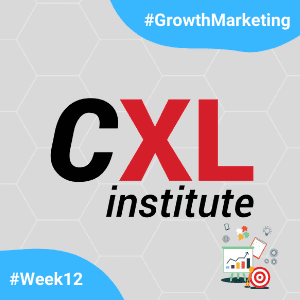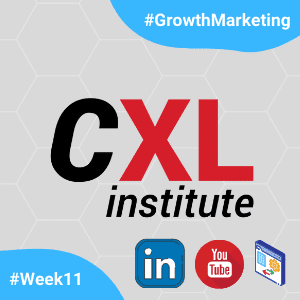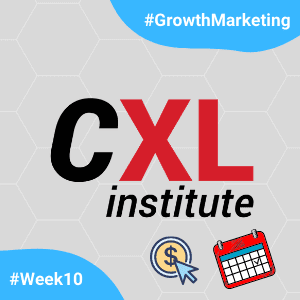Two more courses completed this week!
With the courses Google Tag Manager for beginners and the Attribution, I complete the 6th week of the CXL Institute Scholarship Program!
For 12 weeks, as stipulated by the program, I study the Growth Marketing Minidegree. At the end of each week, I write about my new learnings and courses. Until then, we had the following texts:
- Week 01: organization of the course and the relevance of the theme.
- Week 02: importance of carrying out growth experiments.
- Week 03: A / B tests and fundamentals of statistics for more assertive results.
- Week 04: Google Analytics for beginners. Main features, reports and analysis.
- Week 05: Intermediate Google Analytics. More advanced features, personalized views and new methods to find solutions.
In the sixth week, I finished the third section of the course, Data Analytics, which serves as a crash-course of data analytics skills in order to optimize for our KPI’s. This section ends with the Google Tag Manager (GTM) course, so mentioned in previous weeks, and the Attribution course, focused on making marketing work.
The Google Tag Manager for beginners course is taught by Chris Mercer, already known from other courses. With approximately 7 hours of duration, another tool, essential to the technical digital marketer or business analyst, is presented. In the classes, Mercer displays features, shows how to implement strategies so as not to depend on a developer, gives tips on how to organize the tags and, finally, explains how to understand the obtained results.
The course on Attribution is presented by Russel McActhy, in approximately 2 hours of classes. In a world full of tools, with diverse information, coming from multiple sources, understanding causal links between this information can be a great challenge. In this course, the instructor shows you how to organize the data you have and how to understand consumer behavior based on that information, in order to grow a business.
Below, I organized a small overview of each one of the courses and some of the most notable points.
Google Tag Manager for beginners
(CXL course: GTM for beginners)
The first part of the course deals with the main differences between Tag Manager and Analytics. Mercer shows when to use each tool and where the main opportunities for using it are. The instructor then shows how to install and configure basic GTM items.
In the next section, Getting To Know GTM, Mercer takes a tour of the main aspects of the tool. We see that:
- Tags are used to show GTM WHAT we want it to do.
- Triggers are used to point out WHEN a particular task must be performed.
- Variables are information that we provide for GTM to be able to perform a function.
- Folders are organizational possibilities to keep workflows in order.
- Data Layer is where we temporarily store some data related to a specific action.
- Organization is a constant need. We saw how easy it is to let Tag Manager become disorganized, and with that, how we can lose relevant information if we fail to organize the information correctly.
- Preview Mode is where we can identify exactly how GTM is working, with its inputs and outputs.
- workflow on GTM can involve workspaces and other aspects so as not to overlap jobs and lose information. It is in this lesson that Mercer explains how the work logic works within the tool, considering the features already explained.
Moving on to the next section, Getting Started, we started practicing the tool by creating our first tag. Completing the section, we also see how to deal with scripts and pixels, which is important for properly dealing with social network related features, such as Facebook.
The following section, Tracking Engagement, shows how to register, store and generate intelligence about users’ actions on the site, such as clicks, time on the page, scroll, among others. Finishing the section, we also see how to measure engagement with YouTube videos embedded on the site.
Next, in Data Layer 101, Mercer shows how to write and read information from the created Data Layers. With the user’s journey through the site, various information and behaviors are stored. In this part of the course, we look at how to handle this information in the best way.
In the next short section, Ecommerce, we see how to correlate information related to sales and user behavior in order to generate business intelligence.
Finally, in Deep Dive, the instructor advances on more advanced or complex topics, covering Cross-Domain Tracking, Tag Sequencing and Formatting Variables.
In conclusion, Mercer presents what was seen in the course, in addition to a bonus feature on Form Submissions. Finally, the instructor recommends two interesting resources to continue the journey:blog Simo Ahava’s, which deals with details of GTM and the advanced course on the tool, which is instructed by Simo himself.
Attribution
(CXL course: Attribution)
The course taught by Russel McAthy can be divided into three main parts:
- Basics on Attribution
- Tactics
- Strategic application
Basics on Attribution
In the first part of the course, Russel goes through the main concepts, starting with the definition of Attribution, explaining how it works in the market and how to perform attribution correctly. Next, we see that it is not necessarily an online concept, but that offline and online actions should work in a coordinated way for the assignment to occur correctly.
Russel explains how to use Attribution in the marketing strategy, when attribution is needed and what models are available. Finally, the instructor mentions the different data sources, online and offline, and what data is needed for efficient Assignment.
Tactics
In the second part of the course, Russel shows tactics specific to the channels and how Attribution can be used in each channel. The channels mentioned are:
- CRO
- PPC
- SEO
- Display
- Affiliates
- TV
- Direct Mail
Strategic application
Finally, in the last section of the course, we see important concepts about how Attribution relates to: Value of The Brand, Life Time Value, Customer Data and Value of Visitor.
Next week…
In the next text, I will officially go to the second half of the Growth Marketing Minidegree, starting with one of the most exciting topics in the Digital Marketing market: Conversion. I look forward to what will come!
The founder of the CXL Institute is a renowned Conversion professional, so expectations for the next courses are quite high. Following are texts oncourses Landing Page Optimization and Product Messaging.
See you next week!





